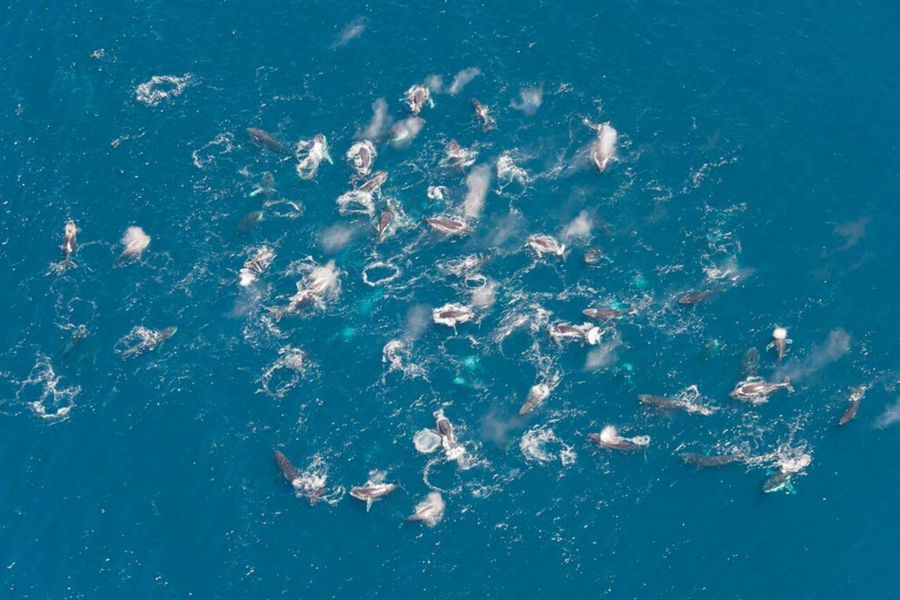What's with the humpback 'super-groups' forming near South Africa?
Loading...
Apparently humpback whales need a change of scenery, too, sometimes.
Scientists have observed the recent emergence of a new behavior in the generally antisocial cetacean: super-groups of dozens to hundreds of individuals engaged in what appears to be regular feeding frenzies off the coast of South Africa. The phenomenon has experts stumped because it breaks with traditional migration patterns, group sizes, and feeding locations.
Humpbacks are usually creatures of habit. They congregate near the southern pole during the Antarctic summer to feast on abundant krill, then retreat to the warmer waters of the subtropics and tropics to birth and raise their young. During this time they “survive off energy reserves accumulated during summer feeding,” wrote the team in a paper published two weeks ago in journal PLOSone.
But change is afoot. Multiple years in a row, marine biologists on a series of three research cruises have caught glimpses of super-groups, which they define as “20 or more individual humpback whales estimated to be within five body lengths of their nearest neighbour.” Some pods even reached triple digits, a rarity for the solitary animal, 10 to 20 of whom used to be considered a “large” group.
Scientists can only speculate as to the shift’s ultimate cause, but the immediate motivation seems clear: food. “Generally, the behaviour of animals within all ‘super-groups’ appeared to be focussed on feeding, with immediate feeding being identified by observations of surface gaping and lunging and tight turning and repeated strong vertical diving behaviour,” the paper reads. Tight whale spacing prevented the researchers from collecting prey samples directly, but they saw swarms of krill amid the whales and harvested local fish with bellies full of mantis shrimp.
More than just isolated incidents, forming super-groups appears to be a thing these whales do now. The three research cruises sighted 22 super-groups in October and November of 2011, 2014, and 2015, strongly suggesting that this behavior recurs in a predictable pattern. Members of the public also reported seven unplanned sightings, three from low-flying planes. These observations also occurred in October and November.
The authors of the paper suggested a number of reasons for the novel feeding behavior, most of which involved the recent surge in humpback whale numbers.
Once pushed to the brink of extinction by commercial whaling, the humpback represents an ecological success story, with 9 of 14 populations making a rare escape from the endangered species list last fall. Some no longer need protection at all, while other populations have had their status downgraded to “threatened.”
“We just saw a lot of whales. So we thought this is a success in ocean management and we wanted to point that out to the world – that things are good with whales in Hawaii,” said Phil Fernandez, president of the Hawaii Fishermen's Alliance for Conservation and Tradition last fall when the species was removed from the endangered list.
With all those whales swimming around, the emergence of unseen behaviors wouldn’t come as a surprise. The paper’s authors suggest greater numbers could be affecting the locations of prey populations, or that we’re seeing the restoration of a natural feeding strategy previously hidden by low numbers.
The development of an entirely new hunting strategy isn’t out of the question either. Cetaceans are notoriously bright animals, and some scientists suspect humpbacks, in particular, may be capable of altruism extending even beyond their own species, as demonstrated by the occasional saving of seals from orca attacks.
“So, taken altogether, these attributes are those of a species with a highly developed degree of general intelligence capable of empathic responses,” Lori Marino, an expert in cetacean intelligence and president of the Whale Sanctuary Project, told National Geographic.






